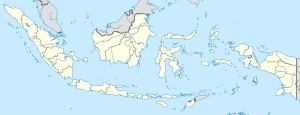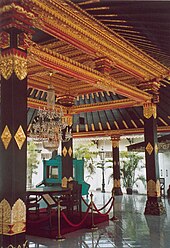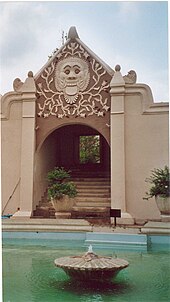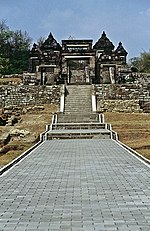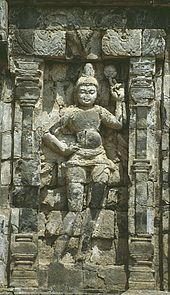Yogyakarta (city)
| Yogyakarta | |||
|---|---|---|---|
|
|
|||
| Coordinates | 7 ° 48 '5 " S , 110 ° 21' 52" E | ||
| Symbols | |||
|
|||
| Basic data | |||
| Country | Indonesia | ||
|
Geographical unit |
Java | ||
| Special region | Yogyakarta | ||
| ISO 3166-2 | ID-YO | ||
| height | 8 m | ||
| surface | 32.8 km² | ||
| Metropolitan area | 2159 km² | ||
| Residents | 511,744 | ||
| Metropolitan area | 4,010,436 (2010) | ||
| density | 15.602 Ew. / km² | ||
| Metropolitan area | 1,857.5 Ew. / km² | ||
| founding | 1756 | ||
| Post Code | 55111-55792 | ||
| Telephone code | (+62) 274 | ||
| politics | |||
| mayor | Haryadi Suyuti | ||
| Others | |||
| License Plate | FROM | ||
|
Malioboro Street in central Yogyakarta
|
|||
Yogyakarta on the map of Indonesia |
Yogyakarta (short form Yogya , former spelling Jogjakarta ) is a city in the center of the Indonesian island of Java in the Sultanate of Yogyakarta .
The city, together with the neighboring city of Surakarta, forms the center of traditional Javanese culture and, due to its numerous universities, is also the educational center of the archipelago.
In 2004 there were 511,744 people in Yogyakarta on 32.8 km². The population of the entire urban area, which extends far into the two neighboring administrative districts (Kabupaten) Sleman and Bantul, is estimated at around 1.5 million.
During the Indonesian War of Independence 1945-1949 Yogyakarta was the capital of Indonesia.
geography
The city of Yogyakarta is the capital of the Province and Special Region Yogyakarta (Daerah Istimewah Yogyakarta, DIY) and is the only city to have the status of a Level II region. The city of Yogya is located near the Javanese south coast in the center of the province of Yogyakarta, which is enclosed in the north by the province of Jawa Tengah (central Java). The city is located in a very active volcanic zone: the double volcanoes Merapi and Merbabu are only about 30 and 40 kilometers to the north. The eruption of the Merapi since the end of October 2010 has affected life in the city with its clouds of ash. Should a major eruption with pyroclastic currents and large ejection volumes occur, considerable casualties and damage would be feared in Yogyakarta.
Two districts (Kabupaten) of Level II border Yogya:
The urban area of Yogyakarta extends on a level, in the north-south direction of which only a gradient of +/- three percent was measured.
Three rivers flow through Yogyakarta:
- Gadjah Wong in the eastern part,
- Code in the middle part and
- Winongo in the western part of the city.
With an area of 32.5 km², the city of Yogyakarta only takes up 1.025 percent of the area of the Yogyakarta region and is therefore rather small for a Status II region .
climate
In Yogyakarta there is an average of 2,012 mm of rain per year on 119 days. The average temperature is 27.2 ° C and the humidity between 70 and 80 percent.
Most of the year, monsoon winds blow in Yogya. During the rainy season, westerly winds (220 °) blow humid air and rain into the city. During the dry season, a light wind from the east (+/- 90 ° to 140 °) blows dry air into the city.
history
See article Yogyakarta
Attractions
- Kraton (Sultan's Palace): The walls of the centuries-old palace complex houses a museum in which mainly traditional court scenes and the corresponding clothing can be admired. You can see the influence of different religions on Javanese culture from the furnishings and decorations in the kraton. For example, symbols and colors of Buddhism , Hinduism and Islam are next to each other on pillars inside the palace .
In front of the kraton is a large village square, the Alun-Alun Utara (village square in the north). Folk festivals and markets take place there regularly. A mosque also belongs to the Kraton area. The palace district is located in the Kota Gede district ("magnificent city"). Kota Gede is partially surrounded by a city wall. The center of Kota Gede is Alun-Alun Selatan ("southern village square"). It is a destination for families on weekends. The Alun-Alun is used in the evenings to play football and is a meeting point for young people. In the middle of the square there are two large old trees in which, according to Javanese belief, ghosts live. There are various expectations that are linked to what happens when you manage to walk blindfolded from the edge of the village square in the middle between the trees: Some people say that you have a pure soul, others claim that you have then one wish is free, others claim it brings luck.
- Taman Sari: ruins of the moated castle (built from 1758 to 1765), restored bathing pool; served the sultan as a pleasure palace, in which the followers of his harem stayed, and is located on the Jalan Taman.
- Pasar Ngasem: bird market , hence the local name “Pasar Burung”.
- Pasar Beringharjo: Main market on Jalan Malioboro ; cloths, fabrics and traditional clothing are offered here. There is also a wide range of spices, fruit, vegetables and other goods for everyday use. On the Pasar Beringharjo people haggle according to old tradition.
- Sono Budoyo Museum: Wayang Kulit figures, Kris , Wayang Topeng (masks) and batik fabrics are exhibited here.
- Affandi Museum: Museum of Impressionist Art
- Benteng Vredeburg: Dutch fort from 1765
- Kota Gede district: In the south of the district there are still many companies that make jewelry, crockery, cutlery and the like from silver by hand. Therefore, Kota Gede can also be called the silver processing center of Java.
- Jalan Malioboro: Is an attraction for domestic and foreign tourists. Around Jalan Malioboro you can find many small shops selling batik and local handicrafts. The road is part of the mythical connection line between the Merapi volcano, the craton and Parangtritis beach. From the kraton, the sultan can look directly at the volcano via a statue (tugu) at the northern end of the road. In the evenings, numerous cookshops are set up on the Malioboro, in which people can eat while sitting on mats, which is also very typical for Yogya.
In the neighborhood:
39 kilometers northwest of Yogyakarta is Borobudur , one of the largest Buddhist temples in the world near the city of Magelang . The Hindu temple complex Prambanan is located on the main road to Surakarta , about 18 kilometers from the city center.
- Between Yogyakarta and the Prambanan Temple, the Kraton Ratu Boko stands on a plateau with a wide view of the Merapi and the valley of the Opak River with the Prambanan complex at its feet . A twelve-step staircase leads to a monumental, three-part gate, but behind which only the palace foundations and a few bathing areas and artificial ponds can be seen of the once huge complex . One of the few written records in Ratu Boko is an inscription dating back to 792 AD that mentions Rakai Panangkaran (746-784), a devout Buddhist ruler of the Sailendra dynasty. However, in addition to a Buddha statue, some Hindu elements were also found here (a yoni and a lingam , Durga and Ganesha statues), which indicate that the palace was taken over by the Mataram rulers .
- About 10 kilometers east of Yogyakarta, on the road to the Prambanan complex, is the Candi Kalasan , a Buddhist temple dedicated to Tara . According to an inscription in Sanskrit , it was consecrated in 778, making it the oldest temple in Central Java. The founder was Rakai Panangkaran, whose wife was called Tara. The building has a cross-shaped polygonal shape, which is divided into a basement , temple body and roof construction. The central cella contains an altar, the design of which indicates that a large bronze Buddha statue must have sat here. Abandoned lotus seats in the side shrines and wall niches of the corridor also suggest the former presence of Buddha and Bodhisattva statues. The outside of the temple is also adorned with niches, each surrounded by fine stone carvings and surmounted by a kala head . The lower part of the tripartite roof is still adapted to the polygonal shape of the temple body and contains niches occupied by Bodhisattvas, which are crowned by small stupas . The sides of the octagonal central part are also adorned with statues, while the upper part of the cantilever vault closes the cella.
- Not far from Candi Kalasan in a north-easterly direction stands the Buddhist Sari temple from the 8th century in the middle of palm forests . Its shape is similar to the Kalasan temple, but its rich relief decoration on the outer walls with a total of 36 statues of Buddhist deities and bodhisattvas is better preserved. The original function of the two-story building was a vihara , which housed the monks on the upper floor. In the basement three cellae are connected by doors.
- Merapi Volcano : In the north of Yogyakarta lies the active 'Merapi' volcano, which can be seen from the city center in good weather. On the mountain is the village of Kaliurang , which has a cooler climate due to its higher location. Because of this and the quieter traffic situation, it is a very popular destination with locals . Since the last major volcanic eruption on May 7, 2006, a group of houses covered by lava has increasingly attracted foreign tourists to Kaliurang.
- Beaches: There are several beaches on the Indian Ocean in the south of the city . Probably the most famous beach is Parangtritis . Parangtritis is a popular destination on weekends, although swimming is not possible due to the strong current. In particular, the mythical queen of the South Seas, Ratu Kidul, whose existence hardly any Javanese doubts and who, according to local understanding, repeatedly demands victims, and the black sand give Parangtritis its special atmosphere. To the east of Parangtritis there are other beaches that can be reached via the town of Wonosari . Krakal Beach is probably the most famous and beautiful beach in the region. Since there are corals and rocks off the coast, swimming is hardly possible. However, its light sandy beach and its seclusion and tranquility attract a small number of day trippers. To the west of Parangtritis is Parang Kusomo, on which there are also two rocks that represent a pilgrimage site for Javanese. In Parang Kusomo, rituals in honor of the sea king Ratu Kidul take place at regular intervals.
Culture
Courtly performing arts include performances of gamelan music and wayang games . From the beginning of the 18th to the beginning of the 20th century, Wayang wong , the drama with made-up but unmasked male actors, was particularly popular in the kraton . The batik dyeing technique is part of Javanese practical art.
traffic
Supraregional: Yogya is connected to international air traffic ( Kuala Lumpur ) through the Adisucipto International Airport . The train stations Yogyakarta (colloquially Tugu Station for the business and executive transport classes ) and Yogyakarta Lempuyangan (for economy class trains) connect Yogyakarta to the cities of Jakarta , Bandung , Surakarta and Surabaya . Coaches and minibuses connect Yogyakarta with the region and all major cities on the island.
In the city area: In Yogyakarta, the local public transport consists of buses, taxis and motorcycle taxis. The public bus system Trans Jogja has 17 routes and has existed since 2008. In some parts of the city there are still traditional means of transport such as. B. Cycle rickshaws (becak). With the Indonesian rickshaw variant, the driver sits behind the passengers. Becak drivers wait in large parts of the city for passengers willing to pay and thereby shape the cityscape to a certain extent. In the area around Jalan Malioboro you can also use horse-drawn carriages (Andong) for transport.
population
Due to the narrow city limits, around 15,200 inhabitants per km² live very densely packed in Yogyakarta. The life expectancy of women is 76.31 years and the life expectancy of the male residents 72.25 years (both as of 2000).
education
Yogyakarta is the educational center of Indonesia with several universities. Over 100,000 students from all over the island live in the city. The Gadjah Mada University (UGM) is the oldest public university in Indonesia and the largest in the city. Alongside Universitas Indonesia (UI) in Jakarta and the Technical University in Bandung, the UGM is one of the three most important universities in the country.
Other educational institutions are:
Indonesian Institute of the Arts - Yogyakarta, Universitas Negeri Yogyakarta, Universitas Islam Indonesia, Universitas Sanata Dharma, Universitas Atma Jaya Yogyakarta, Duta Wacana Christian University, Institut Sains dan Teknologi AKPRIND - Yogyakarta, Universitas Pembangunan Nasional "Veteran" Yogyakarta, Universitas Yogyakarta, Muhammadiyaharta Sekolah Tinggi Teknologi Nasional Yogyakarta, Universitas Teknologi Yogyakarta.
Sports
The city's football club is called PSIM and currently plays in the second highest division in Indonesia .
administration
The city is divided into 14 districts ( kecamatan ):
- Gondokusuman
- Jetis
- Tegalrejo
- Umbulharjo
- Kotagede
- Mergangsan
- Ngampilan
- Danurejan
- Kraton
- Wirobrajan
- Pakualaman
- Mantryon
- Intended
- Gondomananasa
in 45 sub-districts (Kelurahan), 617 street associations (RW - Rumah Wilayah) and 2,531 neighborhood trade associations (RT - Rumah Tangga), each of which is headed by elected administrative officers (Pak Camat, Pak Lurah or Pak Dukuh (Javanese name), Pak RW and Pak RT) .
Personalities
- Erna Spoorenberg (1926–2004), Dutch soprano
- Paul Gutama Soegijo (1934–2019), composer and musician
- Megawati Sukarnoputri (* 1947), politician
- Wiranto (* 1947), General and Minister of Defense
- Djaduk Ferianto (1964–2019), actor, director, musician
- Yayuk Basuki (* 1970), tennis player
- Sigit Budiarto (* 1975), badminton player
literature
- Jacques Dumarçay: The Temples of Java . Oxford University Press, Singapore 1989, pp. 20-34, ISBN 0-19-582595-0 .
- Heimo Rau: Indonesia . Kohlhammer Verlag, Stuttgart 1982, pp. 157-162, ISBN 3-17-007088-6 .
Web links
- Pemerintah Kota Yogyakarta. ( Memento of December 6, 2012 in the Internet Archive ) Website of the city (Indonesian)
Individual evidence
- ^ Yogyakarta, Yogyakarta, Indonesia. kinkaa.com/weather
- ↑ M. Heni Winahyuningsih: page no longer available , searching web archives: Urbanization and the Dialectic of Traditional Performing Arts in Yogyakarta. (PDF)
- ↑ RM Soedarsono: Page no longer available , search in web archives: The Place of Court Dance and Music in the Javanese Kratons and its Relation to the Political Situation. Jurnal Humaniora (PDF)




